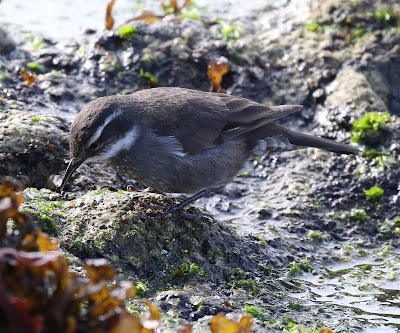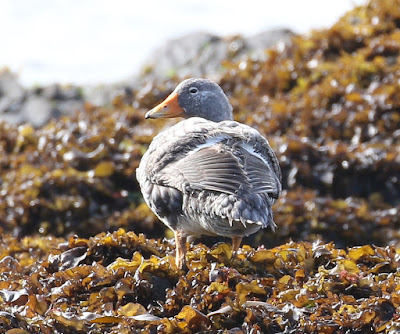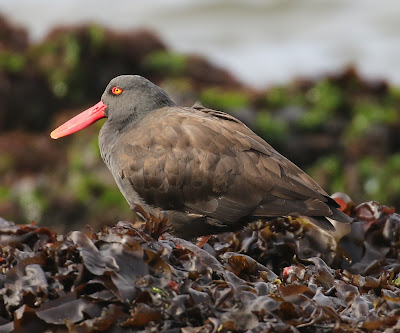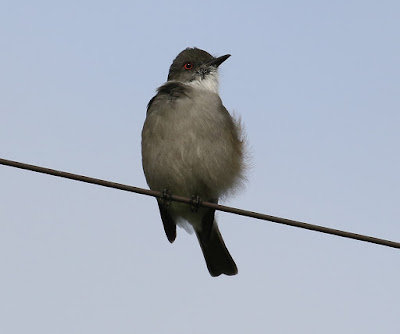It had been a late arrival into Santiago the previous evening & it was a pre-dawn alarm call to get breakfast at the Hostal Sol y Luna near the airport. The owner then dropped me back at the airport for my mid-morning flight. After five hours of flying, including a stop en route, I arrived at Puerto Montt. This is the nearest city to my next destination of Chiloe Island. I quickly collected the hire car which was a one-way drop into Santiago airport on 24 Mar. It was an hour of easy driving on the dual carriageway to Pargua which is the ferry point across to Chiloe Island. The only thing that slowed me down were a few toll booths on the road. Toll booths are a regular feature on the motorway-standard roads in Chile & the tolls quickly mounted up on a long journey.
The ferry to Chiloe Island at Pargua: Within a few minutes I was boarding for the thirty minute crossing
I was Birding from the raised part of the ferry on the crossing. It is a wide channel & not too far from the open sea, so there is always the chance of Seabirds. Very occasionally, Birders have seen the newly described (2013) Pincoya Storm-petrel from the ferry, although March didn't look a likely time of year from eBird. Not surprisingly, I didn't see any on this calm crossing. There were a few Magellanic Penguins, Sooty Shearwaters, Imperial Cormorants & Peruvian Penguins on the crossing.
House Sparrow: An introduced species that seems to survive in many countries outside of its natural range
It was a thirty minute to the Northern town of Ancud where I was staying. I quickly found my self-catering accommodation, the Casa Damasco Chiloe Guesthouse, for the next two nights. A quick look around the town confirmed most of the cafes were shut as it was a Sunday, so I tried one of the hotels for some food, as I hadn't eaten since breakfast. Chiloe Island is a large & pleasant place to visit. There seems to be plenty of places to stay on the island & it has a sleepy laid-back lifestyle that is reminiscent of the islands on the Scottish West coast. It was my favourite part of Chile & I could easily have spent a few more days exploring the island.
Dark-bellied Cinclodes: There were a couple of in the small hotel car park. They have a strong white eyebrow, strong white streaking continuing down the breast, consistent colouration across the middle of the belly, more uniform flanks & longer bill. The very similar-looking Grey-flanked Cinclodes has a paler belly, less streaking on the breast, a thinner white eyebrow & which is browner in front of the eye, a thinner, shorter bill & is a smaller Cinclodes. I've struggled writing this Post on the identification of these two similar Cinclodes, partly as I don't think I saw Grey-flanked Cinclodes on my trip (I would welcome any comments on my identifications)
Dark-bellied Cinclodes: Another photo which I think was also taken at the hotel with the Canon 7D hence the better colouration tones (20 Mar 18)
Dark-bellied Cinclodes: Another at Punihuil Penguin colony
There was still some light to get out Birding as sunset wasn't until 20:15 (sunrise isn't till 08:00). I headed off for the beach by the Punihuil Penguin colony. There is a small colony of Magellanic Penguins on the rocky islands off the beach, but I was more interested in the chance of seeing Marine Otters here. I didn't see any Marine Otters, but there was a reasonable selection of coastal Birds to keep me interested.Dark-bellied Cinclodes: Another at Punihuil Penguin colony
The beach at Punihuil Penguin colony: One of the ribs going out to the Magellanic Penguin colony. There are a couple of Magellanic Penguins on the rocky island
Flightless Steamerduck: I've found identification of lone Steamerducks where both Flying Steamerduck & Flightless Steamerducks occur can be tricky for those newly arrived in their range. The bill looks bulky & deep-based indicating Flightless Steamerduck
Flightless Steamerduck: Identification is made easier when you can see a pair as they are similar in Flightless Steamerducks & a noticeably darker grey colouration in females of Flying Steamerducks. Female Steamerducks also have a green bill with a dull orange base. The other key feature is the wing length which looks very short
After a good look around the bay from the beach, I decided against a trip out on one of the ribs. I was keen to spend the rest of the light driving back along the dirt road heading West from the Magellanic Penguin colony, rather than the main road. I had read that one of the other Birders had bumped into Slender-billed Parakeets along this route. I had no joy on the Slender-billed Parakeet front, but I did see my first Bicoloured Hawk.

























